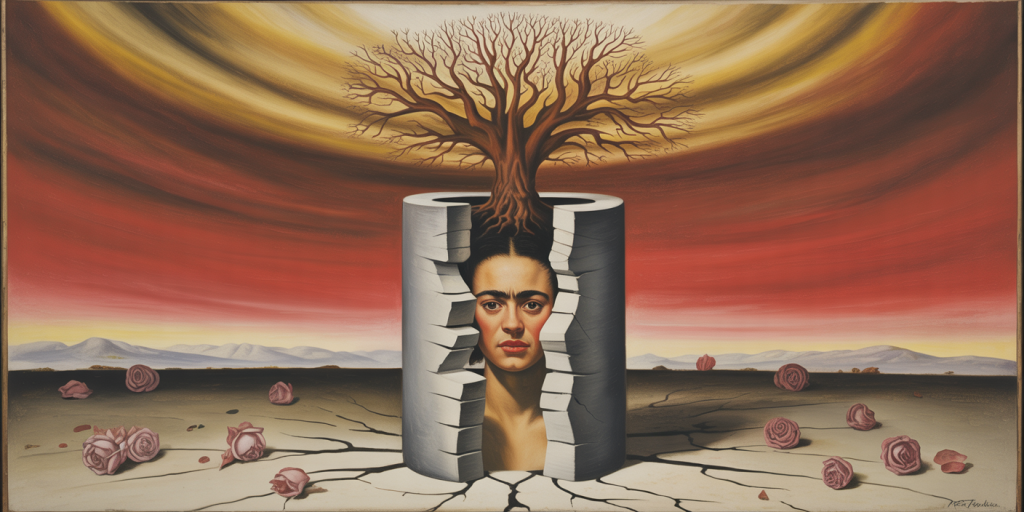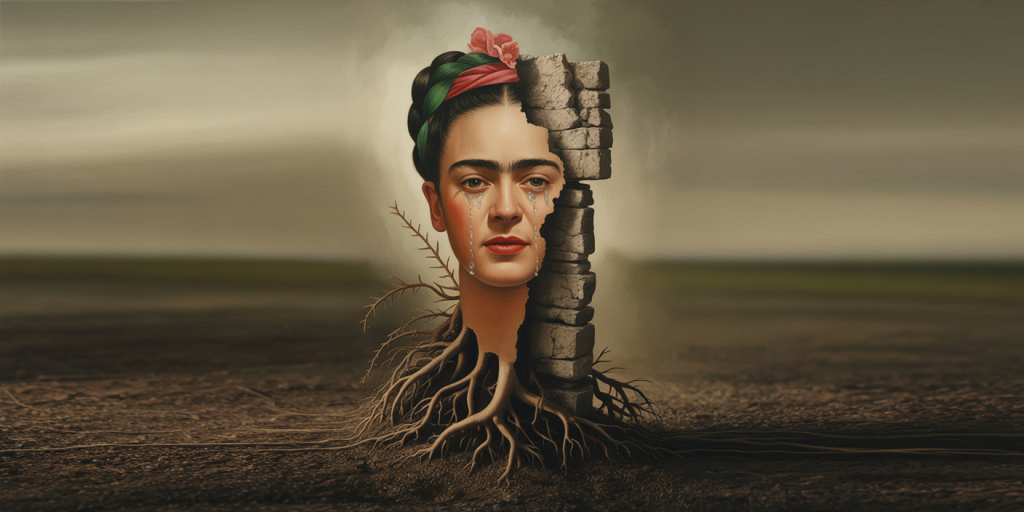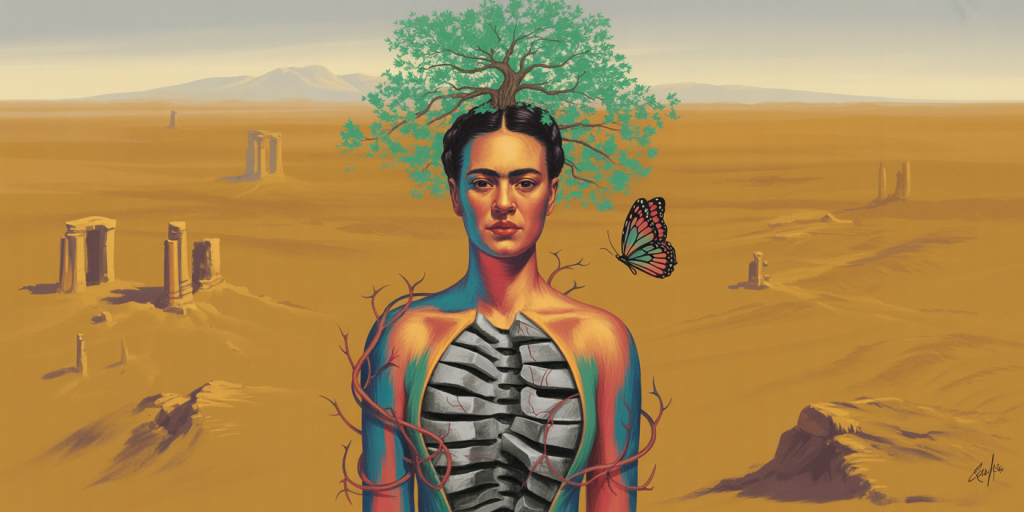Frida Kahlo and the Tree That Grows from the Broken Column
Some pain flowers. Some wounds root themselves in the earth and rise as branches, seeking the sky. In Frida Kahlo’s world, suffering is never silence—it is seed. From her torn spine and scattered tears, a tree bursts forth. A sacred contradiction: fragility becoming force, devastation birthing growth. In her visual confession, we see not only the ache of brokenness, but the fierce defiance that blooms from it.
To stand before Frida’s work is to stand before a garden of scars. There, bones blossom, and flesh becomes the soil of revolution. She paints her pain not to hide it, but to unveil it with ritualistic clarity. She does not flee from agony—she welcomes it, names it, transforms it into leaves and veins. The tree is not separate from the body. It is the body, remembering how to rise.
Table of Contents
- The Flesh Beneath the Bark
- Columns and Cracks
- Roots Where Nerves Once Lived
- Thorns That Speak
- The Earth Holding Her Torso
- The Gaze Between Agony and Grace
- The Dress That Clings Like Bark
- Backgrounds That Refuse to Stay Silent
- The Breasts that Nourish and Wither
- A Face Framed in Storms
- The Body as Cross
- Green That Wounds
- Red as Ancestral Ink
- A Spine Made of Memory
- Between Temple and Tomb
- The Sacred Geometry of Brokenness
- Silence Blooming in Leaves
- The Sky She Still Claims
The Flesh Beneath the Bark
Frida’s torso stands open like a sacred tree split by lightning. The bark of her skin has peeled back to reveal not vulnerability, but resistance. What should have crumbled instead begins to grow. The tree that rises from her body is not decoration—it is declaration.
Columns and Cracks
At the core of her chest lies a broken architectural column—not bone, not flesh, but stone. Classical, cold, cracking. It replaces her spine, offering false support, yet symbolizing eternal endurance. This column is not meant to hold, but to testify. Its ruin is its truth.

Roots Where Nerves Once Lived
From her navel, roots descend, clawing into unseen soil. They are nerves transformed—a nervous system becoming a forest. These roots do not search for water, but for memory. They curl and twist, grounding her in pain and rebirth.
Thorns That Speak
Around her body, sharp thorns emerge. They are not hidden in shadow but placed where they must be noticed. These thorns are voices—screams pressed into pigment. Each one pierces time, marking every betrayal her body has endured.
The Earth Holding Her Torso
The landscape behind her is barren yet sacred. It does not comfort, but it witnesses. Her torso rises from this arid land as if it were altar and offering. Earth becomes the stage for her transfiguration, raw and reverent.
Tears as Fertilizer
Her face holds tears that do not glisten, but fall heavily like fruit from a dying tree. They soak the air, becoming the invisible nourishment for the roots below. Pain feeds growth in Frida’s universe—always.
The Gaze Between Agony and Grace
Her eyes meet ours without pleading. They accuse, confess, withstand. The gaze is not passive; it is priestess-like, delivering the truth of her flesh without adornment. Behind the stare is a refusal to look away from suffering—even when it grows leaves.
The Dress That Clings Like Bark
Her dress does not drape—it clings, like bark around a tree. It is both clothing and armor, both soft and unyielding. The folds become ridges, the fabric a second skin that holds her not with gentleness, but with resolve.

Backgrounds That Refuse to Stay Silent
The background is never neutral in Kahlo’s work. Here, the sky churns with clouds heavy as bruises. The land behind her is not mere backdrop—it is a participant. The environment reflects her internal terrain, painted with the same palette as her wounds.
Rusted Nails and Sacred Rituals
Nails pierce her skin like stigmata. They are not medical, they are ritualistic. Each puncture marks a sacred site of pain. Rusted, not sterile, these nails tie her suffering to sacrifice—a personal crucifixion rendered in feminine flesh.
The Breasts that Nourish and Wither
Her breasts are painted not as erotic, but maternal and mythic. They sit atop a body fractured, yet still capable of nourishing. They are symbols of duality: life and loss, fertility and fragility. They offer what the spine cannot hold.
A Face Framed in Storms
The face remains central. Hair parted, adorned, the brow arched as always. But it is framed by chaos. Her features become the eye of a storm, calm and centered while everything else unravels. The contrast is deliberate—a visual testament to resilience.
The Body as Cross
Arms stretched, spine exposed, nails driven in—the pose recalls crucifixion. Yet this is no martyrdom for belief, but for existence. Frida’s suffering becomes liturgical. Her body becomes the sacred space where human agony is transfigured into visual prayer.
Green That Wounds
The leaves that sprout from her are not lush with comfort. They are jagged, dark, edged with fatigue. Green, in Kahlo’s painting, is not healing. It is persistence. It marks the continuation of life, even when unwelcome.
Red as Ancestral Ink
Red does not simply mark blood; it marks origin. It pulses through her wounds like ancestral ink. Each drop could be from her own pain or from the long history of female suffering she inherits and transforms. Red writes her into lineage.
A Spine Made of Memory
The broken column is not only a spine. It is memory ossified. Each crack is a moment: the bus accident, the surgeries, the betrayals. It is a record of fracture that refuses to be forgotten, written in marble and myth.
Between Temple and Tomb
Her body becomes the threshold. It is neither fully alive nor fully dead. It exists between temple and tomb, place of worship and site of burial. This duality holds her art in tension—always alive with mourning.
The Sacred Geometry of Brokenness
Her composition is mathematical in pain. The vertical spine. The symmetrical arms. The central face. Each element is placed with intention, as if she is mapping the architecture of suffering. Brokenness has structure. It can be drawn.

Silence Blooming in Leaves
Though her mouth remains closed, the leaves speak. They rustle with stories unsaid. The foliage carries the weight of her silence, her thoughts too painful or profound to articulate. This is speech translated into symbol.
The Sky She Still Claims
Above her, the sky looms vast. Unreachable, yet still hers. Despite roots, wounds, and columns, her eyes rise. The heavens remain part of her vocabulary. She does not live beneath them; she dares to become one with their expanse.
FAQ
Who was Frida Kahlo?
Frida Kahlo (1907–1954) was a Mexican painter known for her deeply personal and symbolic self-portraits. Her work blends surrealism, folklore, and autobiography, often exploring pain, identity, and cultural heritage.
What does the broken column represent?
The column symbolizes her fractured spine and lifelong physical suffering. It also serves as a metaphor for internal strength despite external damage.
Why are there nails in her body?
The nails evoke pain and martyrdom, referencing Christian iconography and suggesting that her suffering is both physical and spiritual.
What style did Frida Kahlo paint in?
Though associated with surrealism, Frida rejected labels. Her style is uniquely personal, blending Mexican folk traditions with symbolism and psychological depth.
Why is nature so present in her work?
Nature serves as metaphor and mirror. Flowers, trees, animals, and landscapes reflect her internal states and cultural identity.
Final Reflections: The Garden That Grows Through Pain
Frida Kahlo painted herself as root, as altar, as wound and bloom. Her broken column does not signify an end, but a beginning—the point where pain became expression, where silence took form. The tree that grows from her torso is not a fantasy. It is the most honest thing we can behold: the soul flowering despite suffering.
In her sacred geometry of grief, we find a map of how to rise while broken, how to gaze while pierced, how to grow even when the soil is blood. Frida Kahlo does not offer consolation. She offers transformation. And in her defiant garden of agony, we recognize the stubborn green of our own survival.
